Analysis of Balanced Scorecard Implementation at Thomson Reuters
VerifiedAdded on 2019/09/21
|10
|1702
|420
Case Study
AI Summary
This case study examines the implementation of the balanced scorecard as a strategic tool at Thomson Reuters. It begins with an executive summary outlining the key objectives of the balanced scorecard: prioritizing projects, measuring performance, and aligning work strategy. The study details Thomson Reuters' long-term goals, stakeholder groups, and a strategy map illustrating the interrelationships between different perspectives within the organization. It then explores Key Performance Indicators (KPIs) and Key Performance Drivers (KPDs), explaining their roles in measuring and monitoring performance. A critical analysis of the balanced scorecard's implementation is provided, discussing its strengths and potential limitations. The study concludes by emphasizing the balanced scorecard's importance as a strategic measurement system for Thomson Reuters, offering a framework for creating effective strategies and improving work processes. References to supporting literature are included.
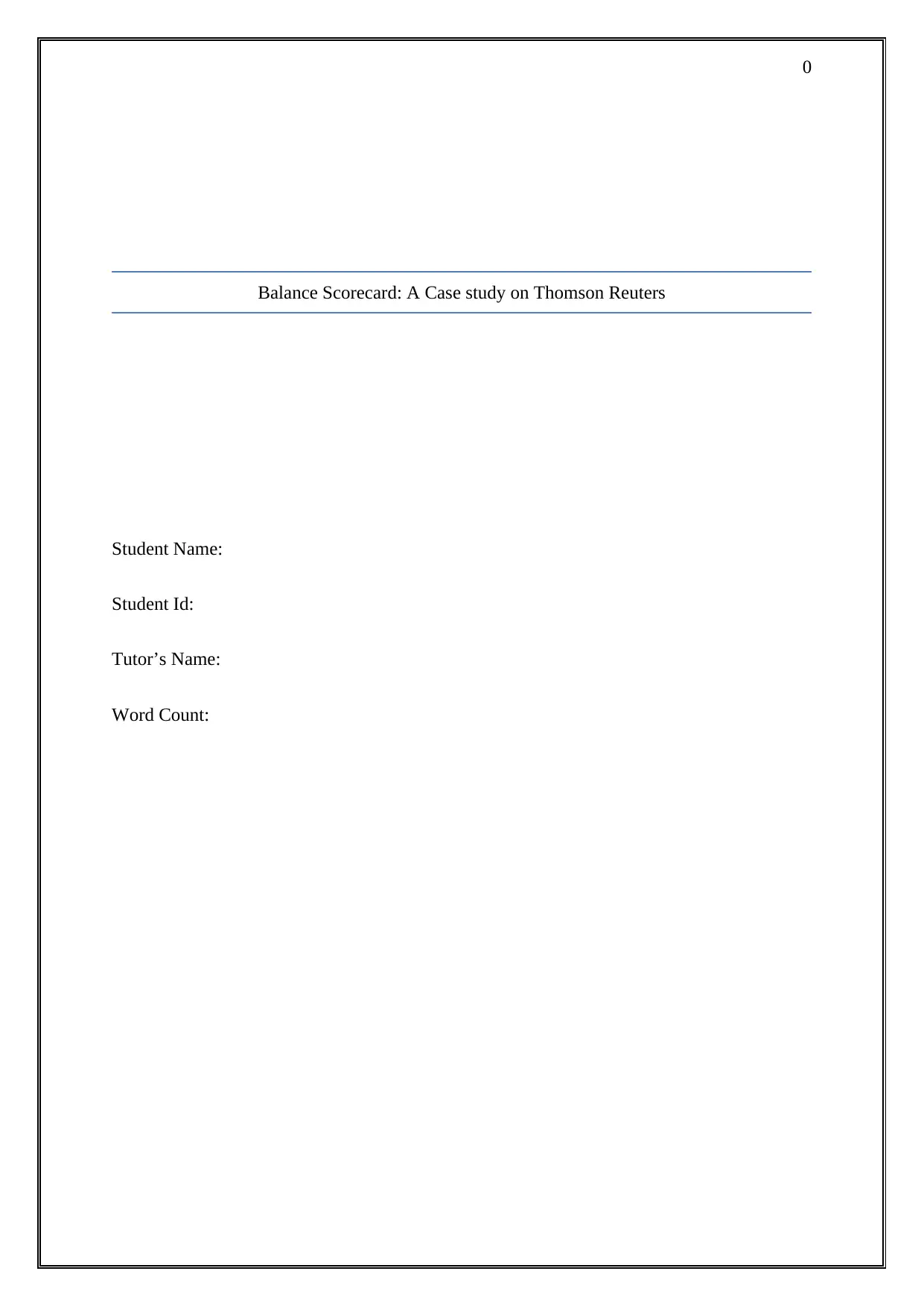
0
Balance Scorecard: A Case study on Thomson Reuters
Student Name:
Student Id:
Tutor’s Name:
Word Count:
Balance Scorecard: A Case study on Thomson Reuters
Student Name:
Student Id:
Tutor’s Name:
Word Count:
Paraphrase This Document
Need a fresh take? Get an instant paraphrase of this document with our AI Paraphraser
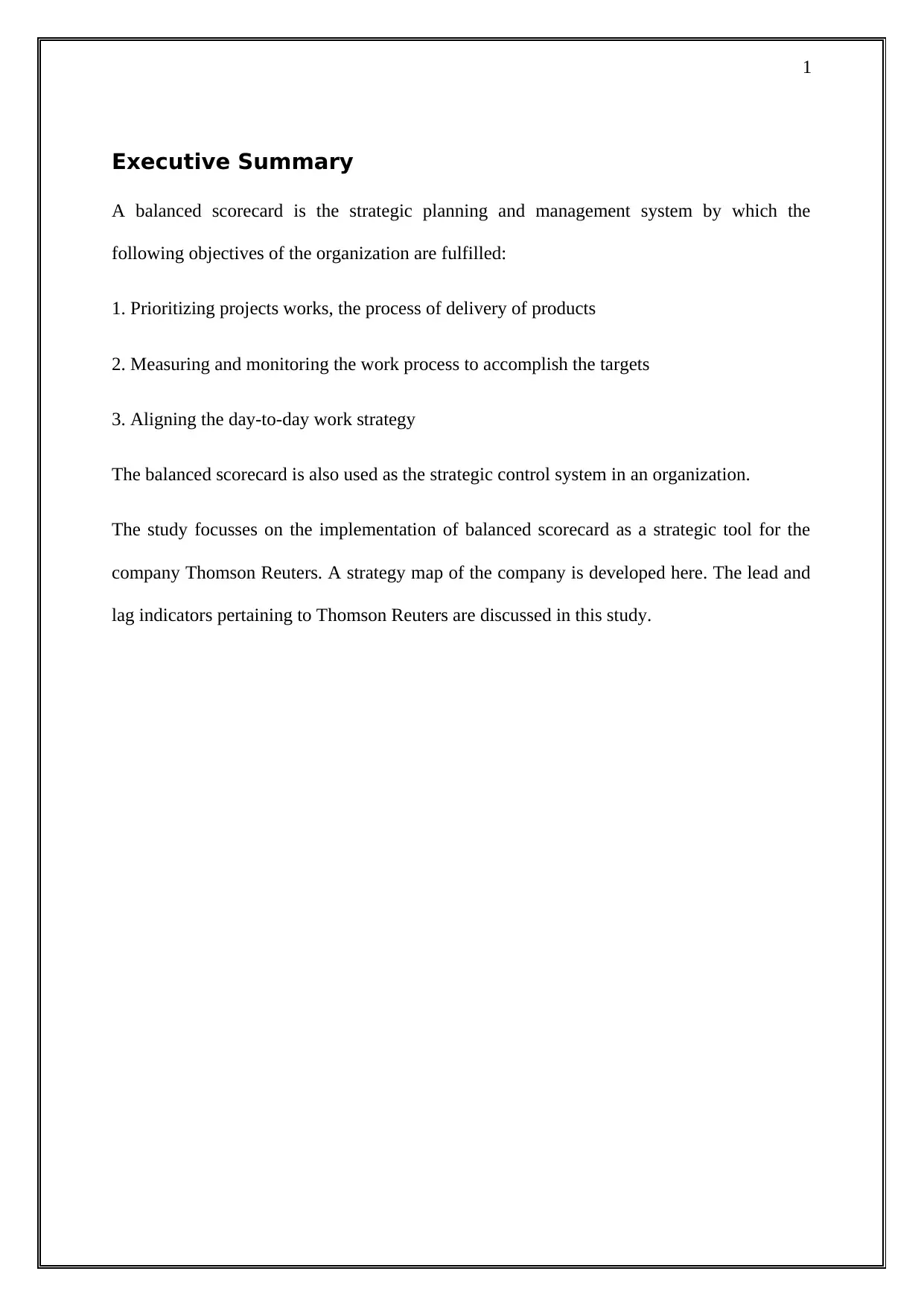
1
Executive Summary
A balanced scorecard is the strategic planning and management system by which the
following objectives of the organization are fulfilled:
1. Prioritizing projects works, the process of delivery of products
2. Measuring and monitoring the work process to accomplish the targets
3. Aligning the day-to-day work strategy
The balanced scorecard is also used as the strategic control system in an organization.
The study focusses on the implementation of balanced scorecard as a strategic tool for the
company Thomson Reuters. A strategy map of the company is developed here. The lead and
lag indicators pertaining to Thomson Reuters are discussed in this study.
Executive Summary
A balanced scorecard is the strategic planning and management system by which the
following objectives of the organization are fulfilled:
1. Prioritizing projects works, the process of delivery of products
2. Measuring and monitoring the work process to accomplish the targets
3. Aligning the day-to-day work strategy
The balanced scorecard is also used as the strategic control system in an organization.
The study focusses on the implementation of balanced scorecard as a strategic tool for the
company Thomson Reuters. A strategy map of the company is developed here. The lead and
lag indicators pertaining to Thomson Reuters are discussed in this study.
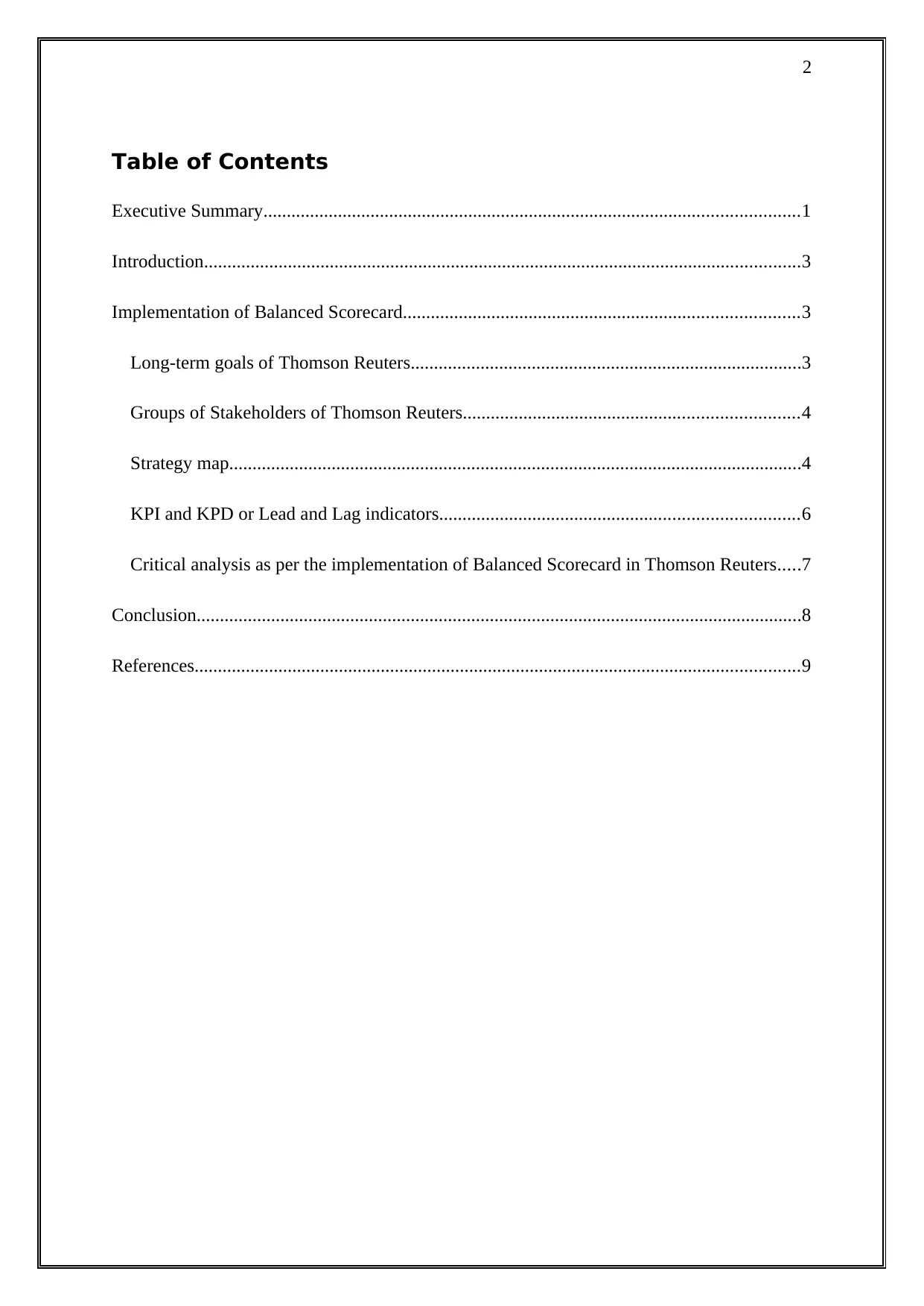
2
Table of Contents
Executive Summary...................................................................................................................1
Introduction................................................................................................................................3
Implementation of Balanced Scorecard.....................................................................................3
Long-term goals of Thomson Reuters....................................................................................3
Groups of Stakeholders of Thomson Reuters........................................................................4
Strategy map...........................................................................................................................4
KPI and KPD or Lead and Lag indicators.............................................................................6
Critical analysis as per the implementation of Balanced Scorecard in Thomson Reuters.....7
Conclusion..................................................................................................................................8
References..................................................................................................................................9
Table of Contents
Executive Summary...................................................................................................................1
Introduction................................................................................................................................3
Implementation of Balanced Scorecard.....................................................................................3
Long-term goals of Thomson Reuters....................................................................................3
Groups of Stakeholders of Thomson Reuters........................................................................4
Strategy map...........................................................................................................................4
KPI and KPD or Lead and Lag indicators.............................................................................6
Critical analysis as per the implementation of Balanced Scorecard in Thomson Reuters.....7
Conclusion..................................................................................................................................8
References..................................................................................................................................9
⊘ This is a preview!⊘
Do you want full access?
Subscribe today to unlock all pages.

Trusted by 1+ million students worldwide
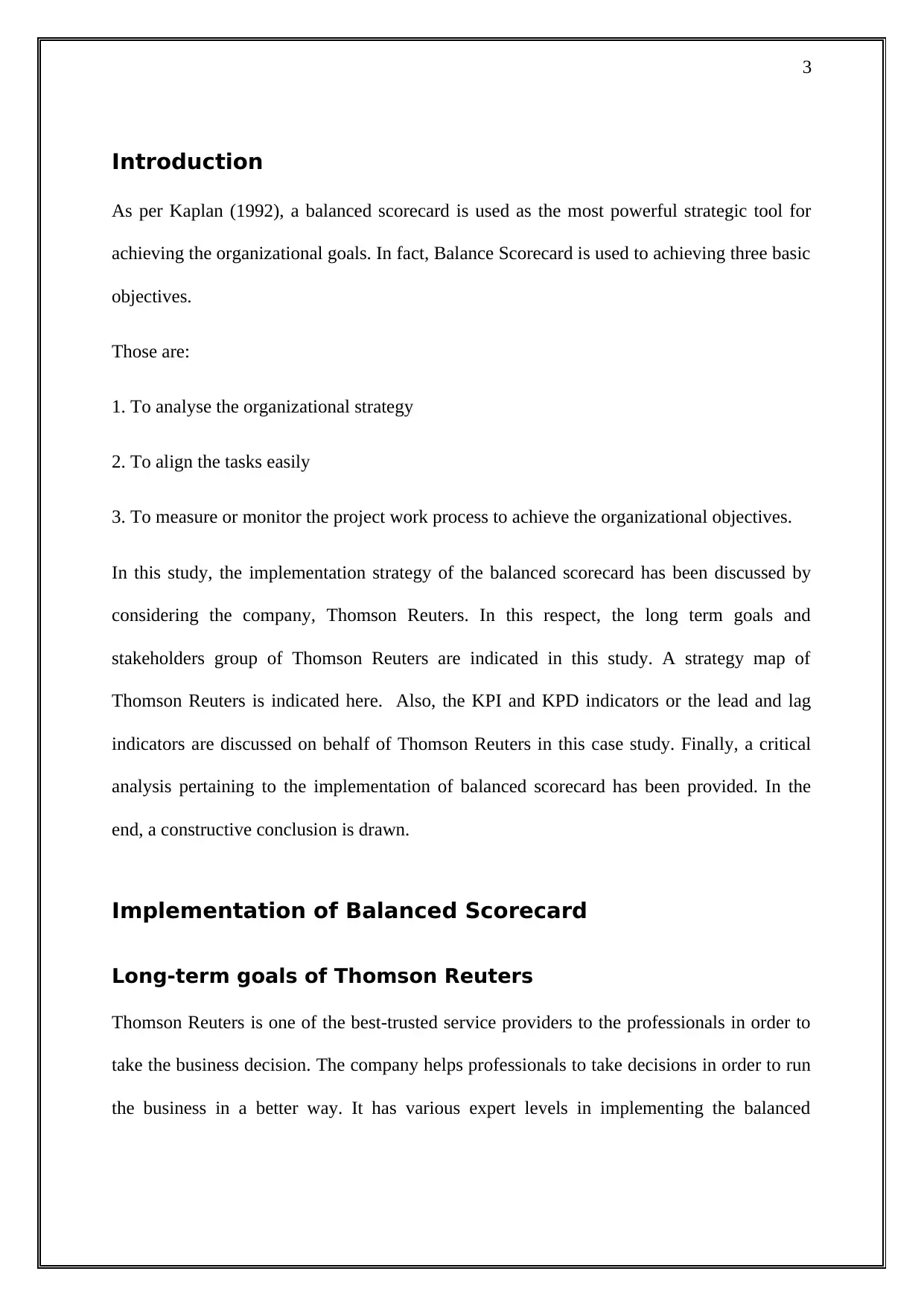
3
Introduction
As per Kaplan (1992), a balanced scorecard is used as the most powerful strategic tool for
achieving the organizational goals. In fact, Balance Scorecard is used to achieving three basic
objectives.
Those are:
1. To analyse the organizational strategy
2. To align the tasks easily
3. To measure or monitor the project work process to achieve the organizational objectives.
In this study, the implementation strategy of the balanced scorecard has been discussed by
considering the company, Thomson Reuters. In this respect, the long term goals and
stakeholders group of Thomson Reuters are indicated in this study. A strategy map of
Thomson Reuters is indicated here. Also, the KPI and KPD indicators or the lead and lag
indicators are discussed on behalf of Thomson Reuters in this case study. Finally, a critical
analysis pertaining to the implementation of balanced scorecard has been provided. In the
end, a constructive conclusion is drawn.
Implementation of Balanced Scorecard
Long-term goals of Thomson Reuters
Thomson Reuters is one of the best-trusted service providers to the professionals in order to
take the business decision. The company helps professionals to take decisions in order to run
the business in a better way. It has various expert levels in implementing the balanced
Introduction
As per Kaplan (1992), a balanced scorecard is used as the most powerful strategic tool for
achieving the organizational goals. In fact, Balance Scorecard is used to achieving three basic
objectives.
Those are:
1. To analyse the organizational strategy
2. To align the tasks easily
3. To measure or monitor the project work process to achieve the organizational objectives.
In this study, the implementation strategy of the balanced scorecard has been discussed by
considering the company, Thomson Reuters. In this respect, the long term goals and
stakeholders group of Thomson Reuters are indicated in this study. A strategy map of
Thomson Reuters is indicated here. Also, the KPI and KPD indicators or the lead and lag
indicators are discussed on behalf of Thomson Reuters in this case study. Finally, a critical
analysis pertaining to the implementation of balanced scorecard has been provided. In the
end, a constructive conclusion is drawn.
Implementation of Balanced Scorecard
Long-term goals of Thomson Reuters
Thomson Reuters is one of the best-trusted service providers to the professionals in order to
take the business decision. The company helps professionals to take decisions in order to run
the business in a better way. It has various expert levels in implementing the balanced
Paraphrase This Document
Need a fresh take? Get an instant paraphrase of this document with our AI Paraphraser
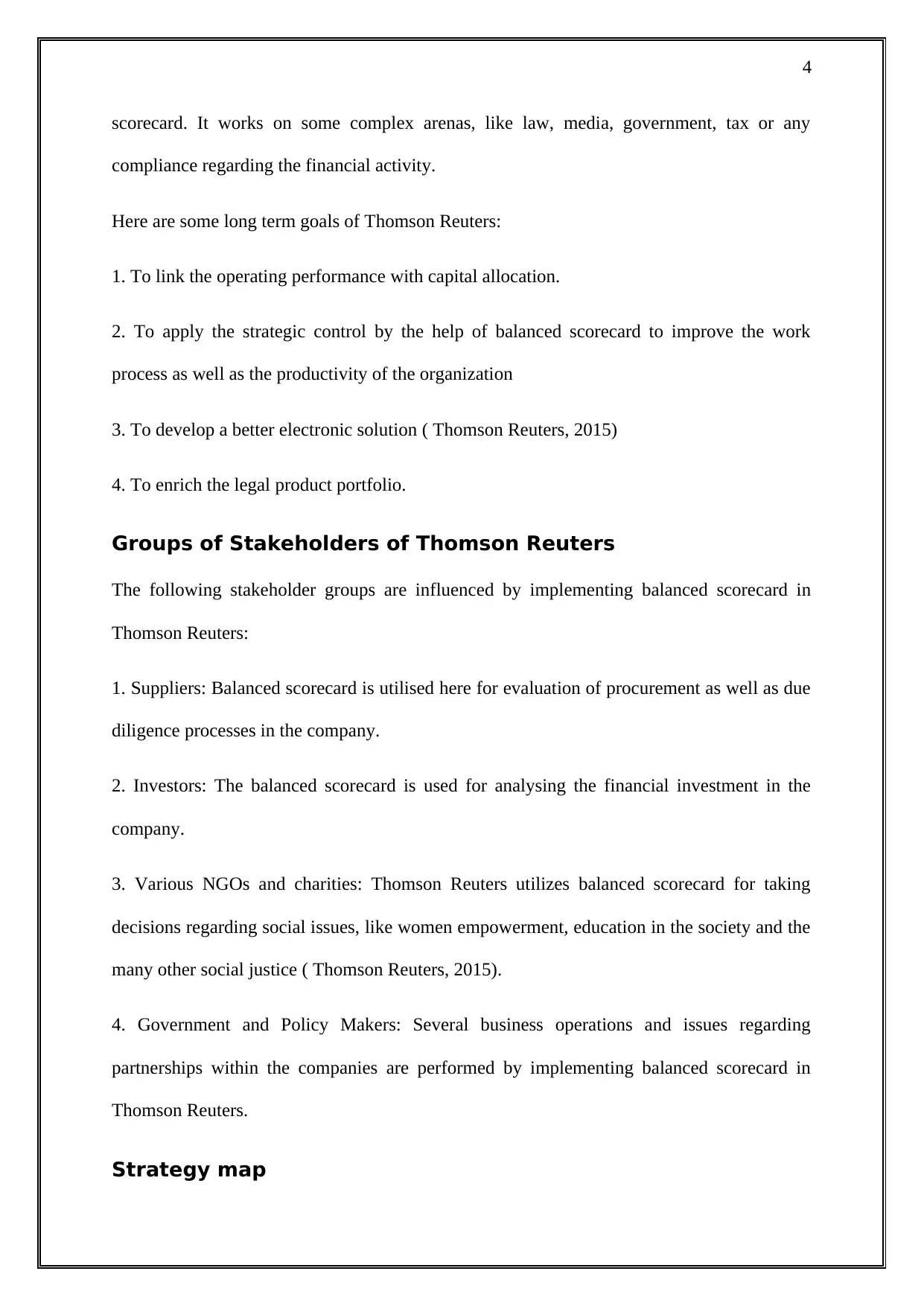
4
scorecard. It works on some complex arenas, like law, media, government, tax or any
compliance regarding the financial activity.
Here are some long term goals of Thomson Reuters:
1. To link the operating performance with capital allocation.
2. To apply the strategic control by the help of balanced scorecard to improve the work
process as well as the productivity of the organization
3. To develop a better electronic solution ( Thomson Reuters, 2015)
4. To enrich the legal product portfolio.
Groups of Stakeholders of Thomson Reuters
The following stakeholder groups are influenced by implementing balanced scorecard in
Thomson Reuters:
1. Suppliers: Balanced scorecard is utilised here for evaluation of procurement as well as due
diligence processes in the company.
2. Investors: The balanced scorecard is used for analysing the financial investment in the
company.
3. Various NGOs and charities: Thomson Reuters utilizes balanced scorecard for taking
decisions regarding social issues, like women empowerment, education in the society and the
many other social justice ( Thomson Reuters, 2015).
4. Government and Policy Makers: Several business operations and issues regarding
partnerships within the companies are performed by implementing balanced scorecard in
Thomson Reuters.
Strategy map
scorecard. It works on some complex arenas, like law, media, government, tax or any
compliance regarding the financial activity.
Here are some long term goals of Thomson Reuters:
1. To link the operating performance with capital allocation.
2. To apply the strategic control by the help of balanced scorecard to improve the work
process as well as the productivity of the organization
3. To develop a better electronic solution ( Thomson Reuters, 2015)
4. To enrich the legal product portfolio.
Groups of Stakeholders of Thomson Reuters
The following stakeholder groups are influenced by implementing balanced scorecard in
Thomson Reuters:
1. Suppliers: Balanced scorecard is utilised here for evaluation of procurement as well as due
diligence processes in the company.
2. Investors: The balanced scorecard is used for analysing the financial investment in the
company.
3. Various NGOs and charities: Thomson Reuters utilizes balanced scorecard for taking
decisions regarding social issues, like women empowerment, education in the society and the
many other social justice ( Thomson Reuters, 2015).
4. Government and Policy Makers: Several business operations and issues regarding
partnerships within the companies are performed by implementing balanced scorecard in
Thomson Reuters.
Strategy map
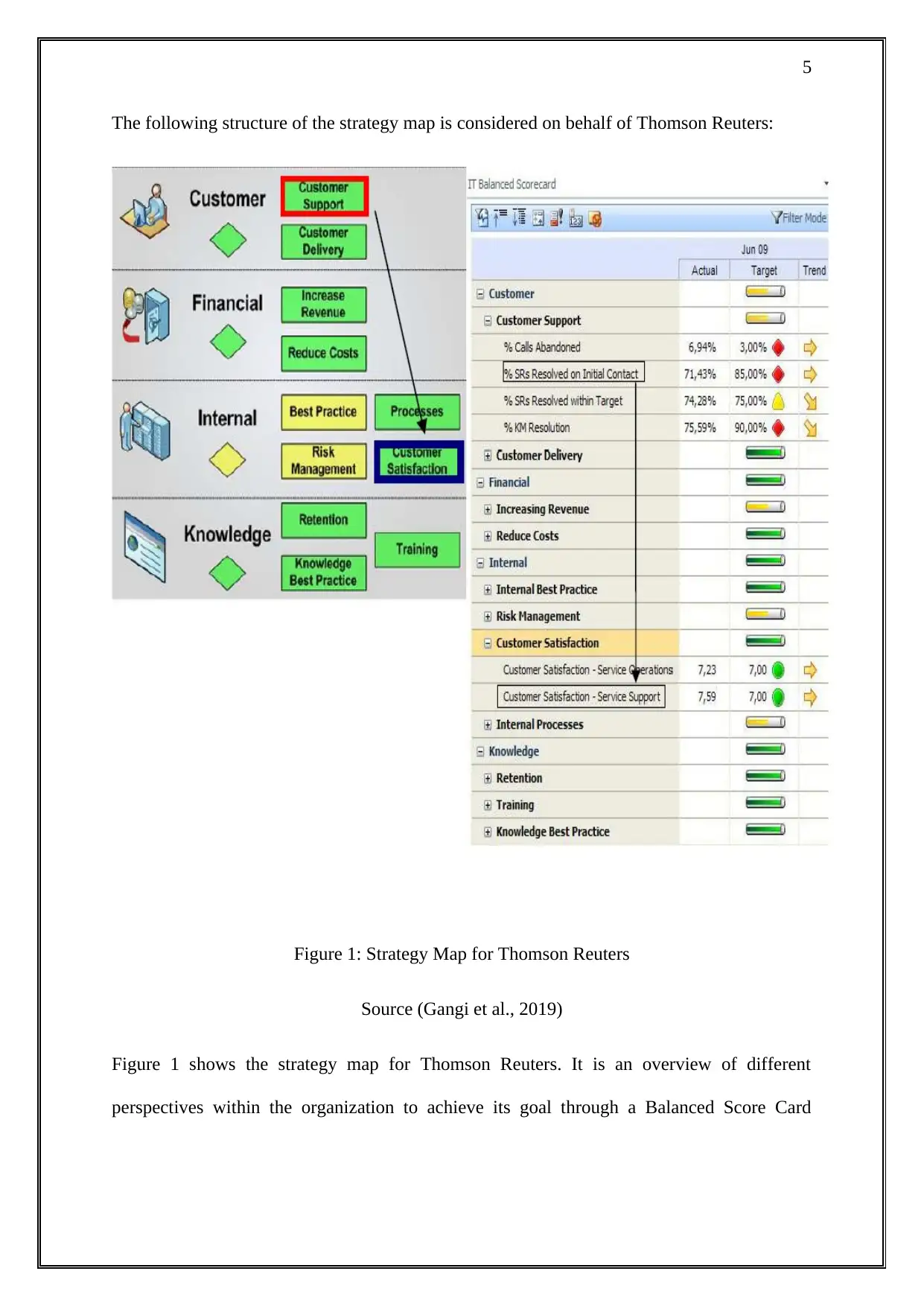
5
The following structure of the strategy map is considered on behalf of Thomson Reuters:
Figure 1: Strategy Map for Thomson Reuters
Source (Gangi et al., 2019)
Figure 1 shows the strategy map for Thomson Reuters. It is an overview of different
perspectives within the organization to achieve its goal through a Balanced Score Card
The following structure of the strategy map is considered on behalf of Thomson Reuters:
Figure 1: Strategy Map for Thomson Reuters
Source (Gangi et al., 2019)
Figure 1 shows the strategy map for Thomson Reuters. It is an overview of different
perspectives within the organization to achieve its goal through a Balanced Score Card
⊘ This is a preview!⊘
Do you want full access?
Subscribe today to unlock all pages.

Trusted by 1+ million students worldwide
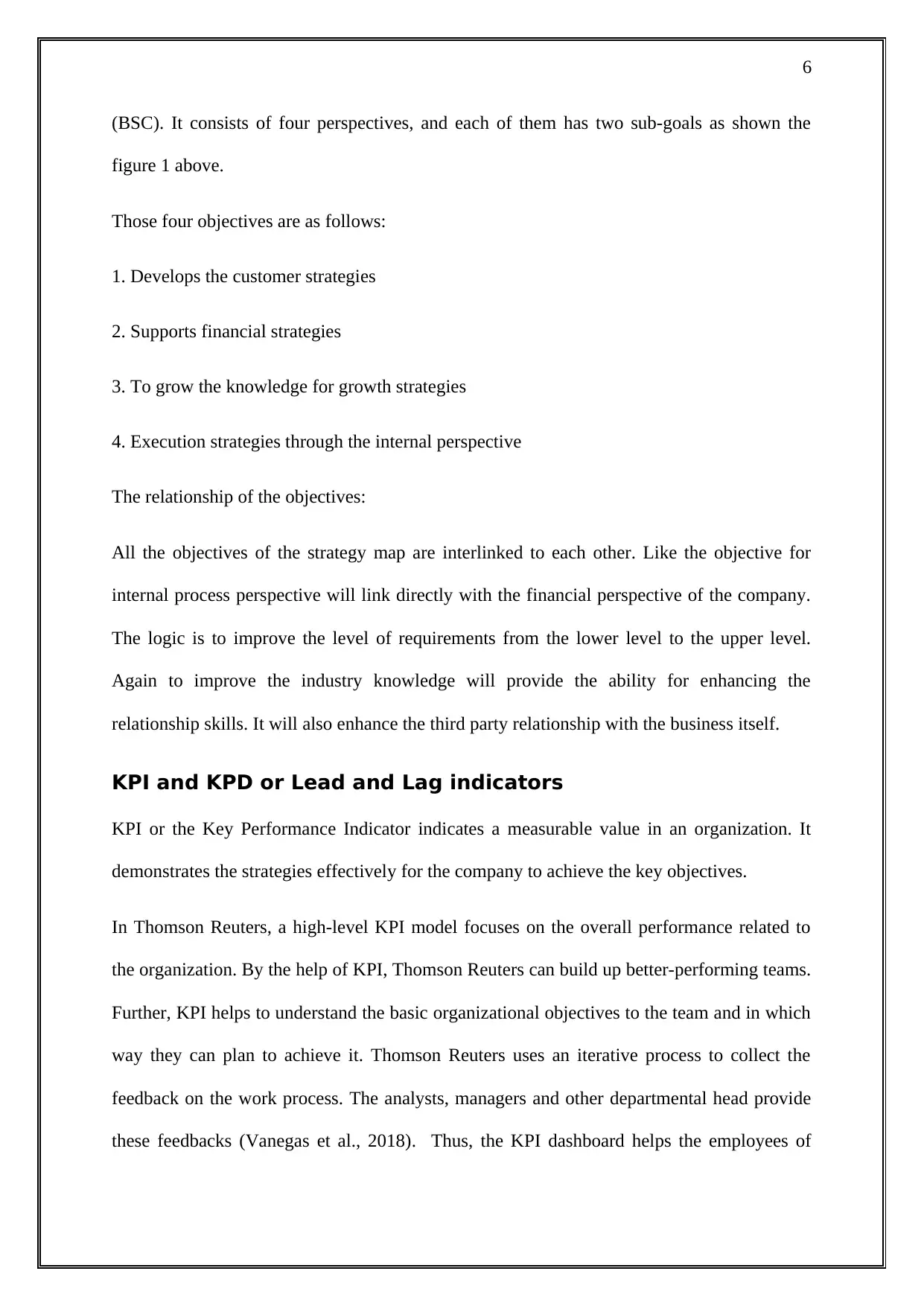
6
(BSC). It consists of four perspectives, and each of them has two sub-goals as shown the
figure 1 above.
Those four objectives are as follows:
1. Develops the customer strategies
2. Supports financial strategies
3. To grow the knowledge for growth strategies
4. Execution strategies through the internal perspective
The relationship of the objectives:
All the objectives of the strategy map are interlinked to each other. Like the objective for
internal process perspective will link directly with the financial perspective of the company.
The logic is to improve the level of requirements from the lower level to the upper level.
Again to improve the industry knowledge will provide the ability for enhancing the
relationship skills. It will also enhance the third party relationship with the business itself.
KPI and KPD or Lead and Lag indicators
KPI or the Key Performance Indicator indicates a measurable value in an organization. It
demonstrates the strategies effectively for the company to achieve the key objectives.
In Thomson Reuters, a high-level KPI model focuses on the overall performance related to
the organization. By the help of KPI, Thomson Reuters can build up better-performing teams.
Further, KPI helps to understand the basic organizational objectives to the team and in which
way they can plan to achieve it. Thomson Reuters uses an iterative process to collect the
feedback on the work process. The analysts, managers and other departmental head provide
these feedbacks (Vanegas et al., 2018). Thus, the KPI dashboard helps the employees of
(BSC). It consists of four perspectives, and each of them has two sub-goals as shown the
figure 1 above.
Those four objectives are as follows:
1. Develops the customer strategies
2. Supports financial strategies
3. To grow the knowledge for growth strategies
4. Execution strategies through the internal perspective
The relationship of the objectives:
All the objectives of the strategy map are interlinked to each other. Like the objective for
internal process perspective will link directly with the financial perspective of the company.
The logic is to improve the level of requirements from the lower level to the upper level.
Again to improve the industry knowledge will provide the ability for enhancing the
relationship skills. It will also enhance the third party relationship with the business itself.
KPI and KPD or Lead and Lag indicators
KPI or the Key Performance Indicator indicates a measurable value in an organization. It
demonstrates the strategies effectively for the company to achieve the key objectives.
In Thomson Reuters, a high-level KPI model focuses on the overall performance related to
the organization. By the help of KPI, Thomson Reuters can build up better-performing teams.
Further, KPI helps to understand the basic organizational objectives to the team and in which
way they can plan to achieve it. Thomson Reuters uses an iterative process to collect the
feedback on the work process. The analysts, managers and other departmental head provide
these feedbacks (Vanegas et al., 2018). Thus, the KPI dashboard helps the employees of
Paraphrase This Document
Need a fresh take? Get an instant paraphrase of this document with our AI Paraphraser
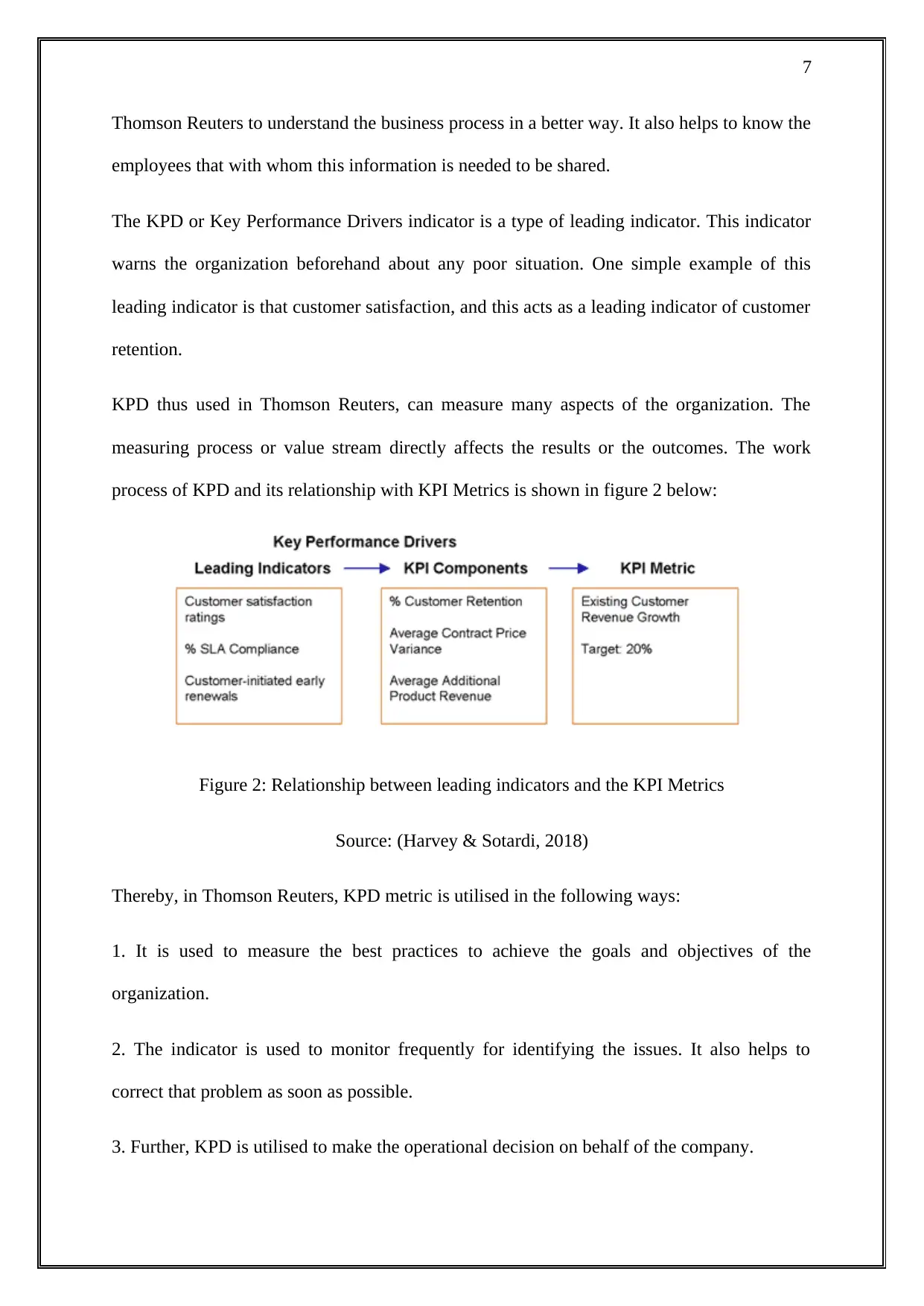
7
Thomson Reuters to understand the business process in a better way. It also helps to know the
employees that with whom this information is needed to be shared.
The KPD or Key Performance Drivers indicator is a type of leading indicator. This indicator
warns the organization beforehand about any poor situation. One simple example of this
leading indicator is that customer satisfaction, and this acts as a leading indicator of customer
retention.
KPD thus used in Thomson Reuters, can measure many aspects of the organization. The
measuring process or value stream directly affects the results or the outcomes. The work
process of KPD and its relationship with KPI Metrics is shown in figure 2 below:
Figure 2: Relationship between leading indicators and the KPI Metrics
Source: (Harvey & Sotardi, 2018)
Thereby, in Thomson Reuters, KPD metric is utilised in the following ways:
1. It is used to measure the best practices to achieve the goals and objectives of the
organization.
2. The indicator is used to monitor frequently for identifying the issues. It also helps to
correct that problem as soon as possible.
3. Further, KPD is utilised to make the operational decision on behalf of the company.
Thomson Reuters to understand the business process in a better way. It also helps to know the
employees that with whom this information is needed to be shared.
The KPD or Key Performance Drivers indicator is a type of leading indicator. This indicator
warns the organization beforehand about any poor situation. One simple example of this
leading indicator is that customer satisfaction, and this acts as a leading indicator of customer
retention.
KPD thus used in Thomson Reuters, can measure many aspects of the organization. The
measuring process or value stream directly affects the results or the outcomes. The work
process of KPD and its relationship with KPI Metrics is shown in figure 2 below:
Figure 2: Relationship between leading indicators and the KPI Metrics
Source: (Harvey & Sotardi, 2018)
Thereby, in Thomson Reuters, KPD metric is utilised in the following ways:
1. It is used to measure the best practices to achieve the goals and objectives of the
organization.
2. The indicator is used to monitor frequently for identifying the issues. It also helps to
correct that problem as soon as possible.
3. Further, KPD is utilised to make the operational decision on behalf of the company.
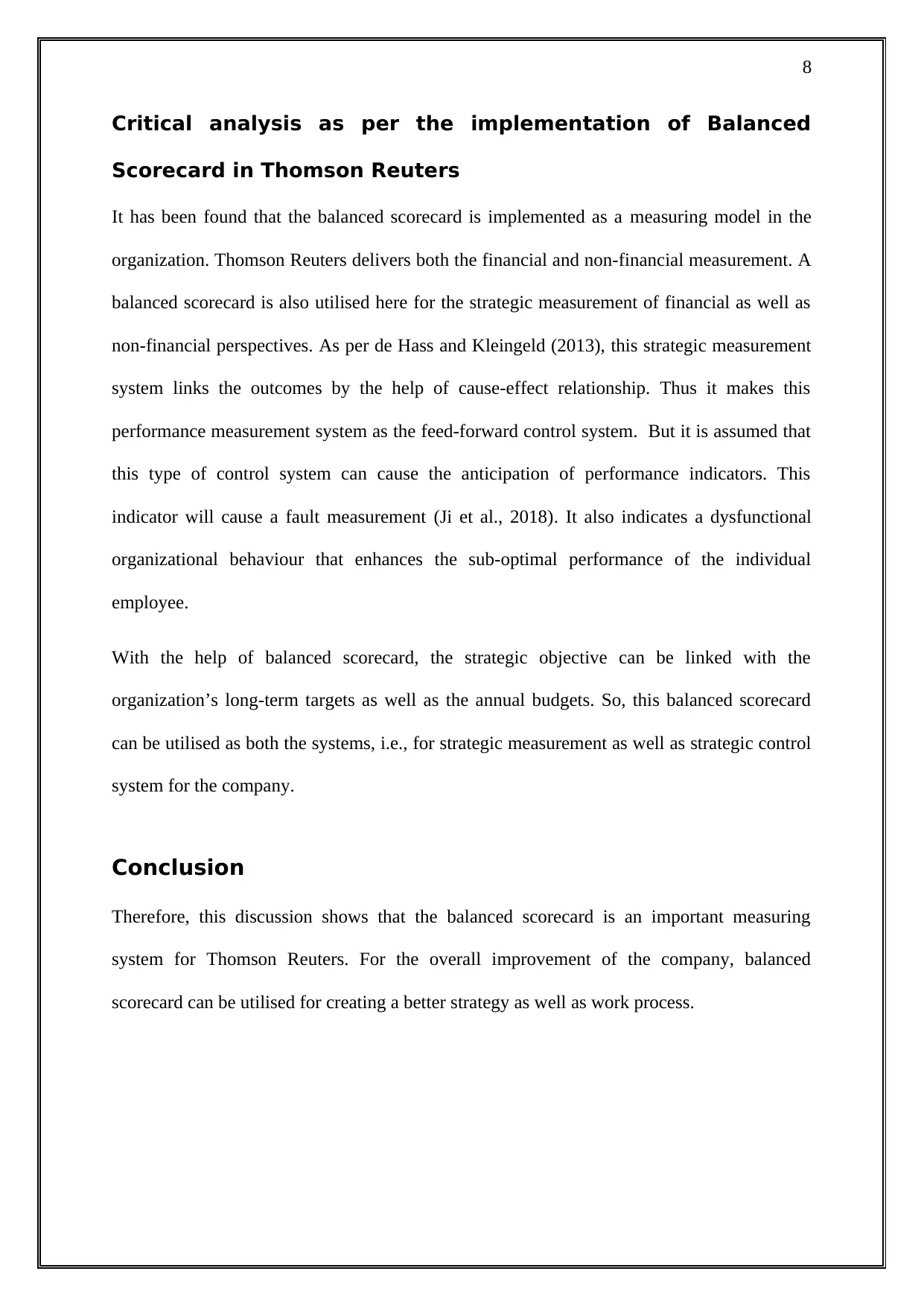
8
Critical analysis as per the implementation of Balanced
Scorecard in Thomson Reuters
It has been found that the balanced scorecard is implemented as a measuring model in the
organization. Thomson Reuters delivers both the financial and non-financial measurement. A
balanced scorecard is also utilised here for the strategic measurement of financial as well as
non-financial perspectives. As per de Hass and Kleingeld (2013), this strategic measurement
system links the outcomes by the help of cause-effect relationship. Thus it makes this
performance measurement system as the feed-forward control system. But it is assumed that
this type of control system can cause the anticipation of performance indicators. This
indicator will cause a fault measurement (Ji et al., 2018). It also indicates a dysfunctional
organizational behaviour that enhances the sub-optimal performance of the individual
employee.
With the help of balanced scorecard, the strategic objective can be linked with the
organization’s long-term targets as well as the annual budgets. So, this balanced scorecard
can be utilised as both the systems, i.e., for strategic measurement as well as strategic control
system for the company.
Conclusion
Therefore, this discussion shows that the balanced scorecard is an important measuring
system for Thomson Reuters. For the overall improvement of the company, balanced
scorecard can be utilised for creating a better strategy as well as work process.
Critical analysis as per the implementation of Balanced
Scorecard in Thomson Reuters
It has been found that the balanced scorecard is implemented as a measuring model in the
organization. Thomson Reuters delivers both the financial and non-financial measurement. A
balanced scorecard is also utilised here for the strategic measurement of financial as well as
non-financial perspectives. As per de Hass and Kleingeld (2013), this strategic measurement
system links the outcomes by the help of cause-effect relationship. Thus it makes this
performance measurement system as the feed-forward control system. But it is assumed that
this type of control system can cause the anticipation of performance indicators. This
indicator will cause a fault measurement (Ji et al., 2018). It also indicates a dysfunctional
organizational behaviour that enhances the sub-optimal performance of the individual
employee.
With the help of balanced scorecard, the strategic objective can be linked with the
organization’s long-term targets as well as the annual budgets. So, this balanced scorecard
can be utilised as both the systems, i.e., for strategic measurement as well as strategic control
system for the company.
Conclusion
Therefore, this discussion shows that the balanced scorecard is an important measuring
system for Thomson Reuters. For the overall improvement of the company, balanced
scorecard can be utilised for creating a better strategy as well as work process.
⊘ This is a preview!⊘
Do you want full access?
Subscribe today to unlock all pages.

Trusted by 1+ million students worldwide
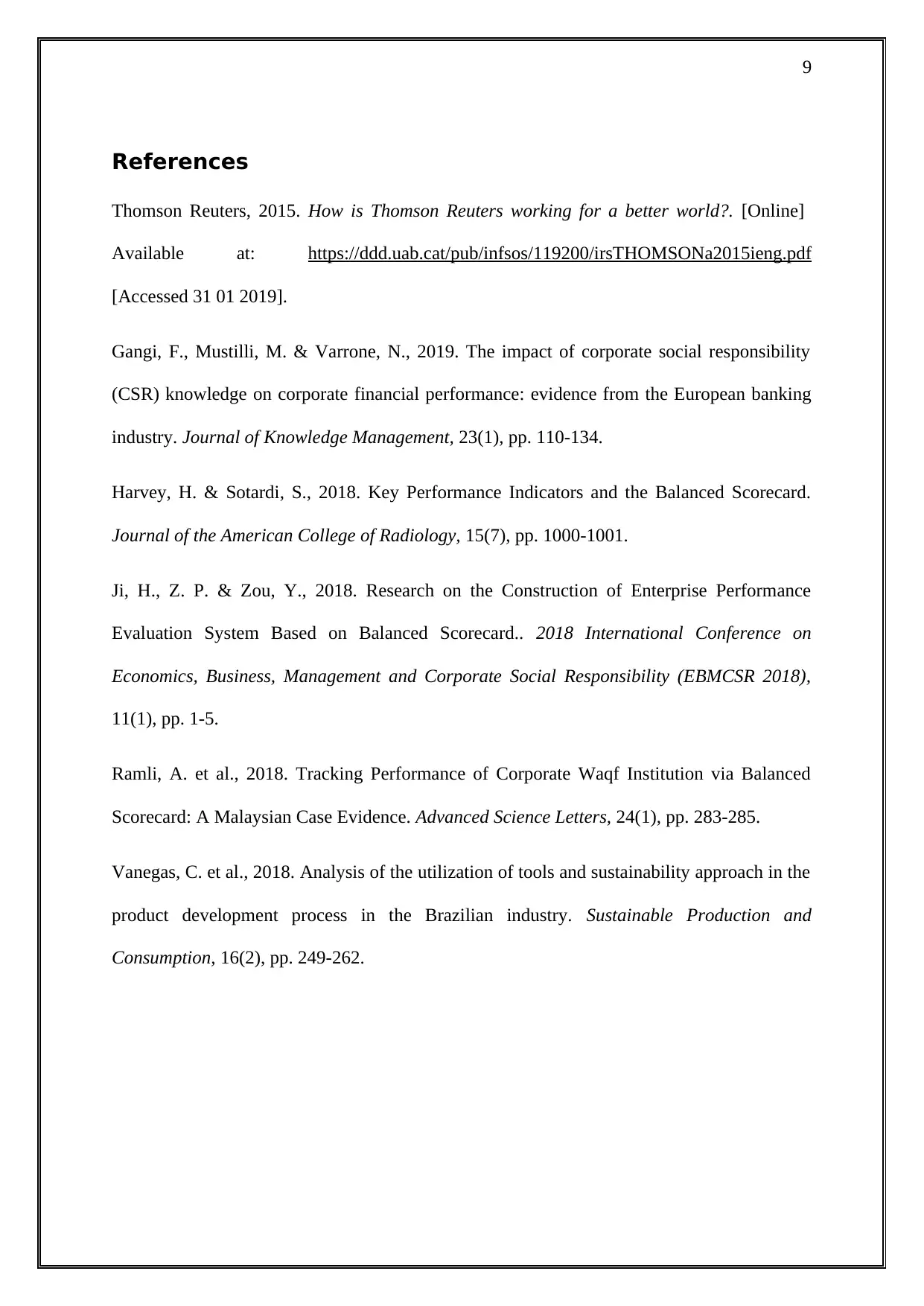
9
References
Thomson Reuters, 2015. How is Thomson Reuters working for a better world?. [Online]
Available at: https://ddd.uab.cat/pub/infsos/119200/irsTHOMSONa2015ieng.pdf
[Accessed 31 01 2019].
Gangi, F., Mustilli, M. & Varrone, N., 2019. The impact of corporate social responsibility
(CSR) knowledge on corporate financial performance: evidence from the European banking
industry. Journal of Knowledge Management, 23(1), pp. 110-134.
Harvey, H. & Sotardi, S., 2018. Key Performance Indicators and the Balanced Scorecard.
Journal of the American College of Radiology, 15(7), pp. 1000-1001.
Ji, H., Z. P. & Zou, Y., 2018. Research on the Construction of Enterprise Performance
Evaluation System Based on Balanced Scorecard.. 2018 International Conference on
Economics, Business, Management and Corporate Social Responsibility (EBMCSR 2018),
11(1), pp. 1-5.
Ramli, A. et al., 2018. Tracking Performance of Corporate Waqf Institution via Balanced
Scorecard: A Malaysian Case Evidence. Advanced Science Letters, 24(1), pp. 283-285.
Vanegas, C. et al., 2018. Analysis of the utilization of tools and sustainability approach in the
product development process in the Brazilian industry. Sustainable Production and
Consumption, 16(2), pp. 249-262.
References
Thomson Reuters, 2015. How is Thomson Reuters working for a better world?. [Online]
Available at: https://ddd.uab.cat/pub/infsos/119200/irsTHOMSONa2015ieng.pdf
[Accessed 31 01 2019].
Gangi, F., Mustilli, M. & Varrone, N., 2019. The impact of corporate social responsibility
(CSR) knowledge on corporate financial performance: evidence from the European banking
industry. Journal of Knowledge Management, 23(1), pp. 110-134.
Harvey, H. & Sotardi, S., 2018. Key Performance Indicators and the Balanced Scorecard.
Journal of the American College of Radiology, 15(7), pp. 1000-1001.
Ji, H., Z. P. & Zou, Y., 2018. Research on the Construction of Enterprise Performance
Evaluation System Based on Balanced Scorecard.. 2018 International Conference on
Economics, Business, Management and Corporate Social Responsibility (EBMCSR 2018),
11(1), pp. 1-5.
Ramli, A. et al., 2018. Tracking Performance of Corporate Waqf Institution via Balanced
Scorecard: A Malaysian Case Evidence. Advanced Science Letters, 24(1), pp. 283-285.
Vanegas, C. et al., 2018. Analysis of the utilization of tools and sustainability approach in the
product development process in the Brazilian industry. Sustainable Production and
Consumption, 16(2), pp. 249-262.
1 out of 10
Related Documents
Your All-in-One AI-Powered Toolkit for Academic Success.
+13062052269
info@desklib.com
Available 24*7 on WhatsApp / Email
![[object Object]](/_next/static/media/star-bottom.7253800d.svg)
Unlock your academic potential
Copyright © 2020–2025 A2Z Services. All Rights Reserved. Developed and managed by ZUCOL.





